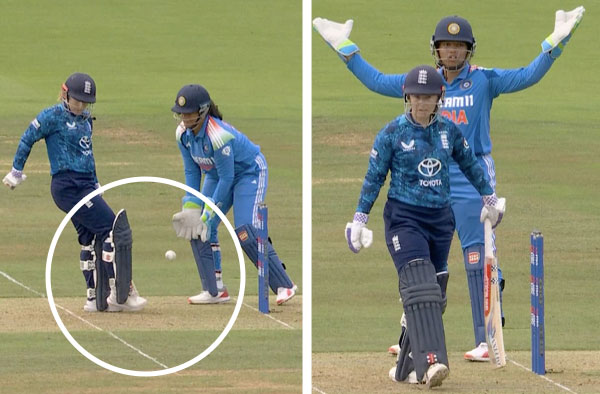India last played an ODI at Lord’s in 2022, a match that ended in controversy despite a 16-run victory for the visitors. During that clash, Freya Davies was on strike while Charlie Dean, batting on 47, backed up too far at the non-striker’s end. Deepti Sharma, noticing this, paused in her delivery stride and ran Dean out. The third umpire confirmed the dismissal, sparking widespread debate but sealing a dramatic win for India.

Controversy returned once again when India faced England at Lord’s on July 19, 2025, in the second ODI of the series. In a rain-affected encounter, India posted 143 runs in 29 overs. With further rain interruptions, England’s target was revised to 115 runs in 24 overs. The hosts comfortably chased down the total with three overs to spare, riding on a strong 54-run opening stand between Amy Jones and Tammy Beaumont.
Although Deepti Sharma wasn’t directly involved in controversy this time, the incident occurred while she was bowling. On the fifth ball of the fifth over, Tammy Beaumont flicked a delivery from Deepti towards mid-wicket. Jemimah Rodrigues cut it off quickly and fired a throw to the striker’s end. Richa Ghosh and Jemimah appealed for a run-out, suggesting that the ball had deflected off Beaumont’s pad.
Watch Video: Tammy Beaumont’s Field Obstruction Controversy
While it appeared Beaumont was inside her crease, her right leg was still in motion as she tried to regain ground. On-field umpires Rob White and Anna Harris referred the appeal to third umpire Jacqueline Williams. After a careful review, Beaumont was ruled not out, as it was judged she was legitimately trying to return to her crease.
At the time of the appeal, Beaumont was batting on 25 off 17 balls. She eventually scored 34 from 35 balls, including five boundaries, before being dismissed by Sneh Rana. England secured an 8-wicket win and levelled the three-match ODI series at 1-1.
While the match ended without incident on the scoreboard, the obstruction appeal reignited debates around the interpretation of MCC laws, particularly regarding intent. Critics argue that laws like “Obstructing the Field” need clearer definitions to avoid confusion and ensure consistency.
MCC Law on Obstructing the Field:
37.1 Out Obstructing the field
-
37.1.1: Either batter is out obstructing the field if, while the ball is in play, they wilfully attempt to obstruct or distract the fielding side by word or action (except in circumstances of 37.2).
-
37.1.2: The striker is out if they wilfully strike the ball with a hand not holding the bat while receiving the ball.
-
37.1.3: This law applies even if a No ball is called.
37.2 Not Out Obstructing the field
A batter shall not be out if:
-
The obstruction or distraction is accidental,
-
The obstruction is to avoid injury,
-
In the striker’s case, if a second strike is made to lawfully defend their wicket (as per Law 34.3).
As the series heads to a decider, players and officials alike will hope the focus shifts back to cricket, rather than controversy. The final ODI promises to be a fitting end to a competitive and eventful series between two top sides in women’s cricket.

Loves all things female cricket